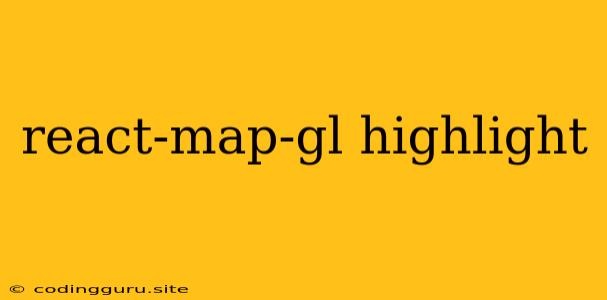Highlighting Locations on Your React Maps with react-map-gl
Ever needed to bring attention to specific locations on your interactive map built with react-map-gl? Highlighting points of interest or key locations is a common requirement in web applications that use maps. This article will guide you through the process of implementing effective location highlighting using the powerful react-map-gl library.
Why Highlight Locations?
Highlighting locations on your map can enhance user experience and communication in several ways:
- Drawing Attention: Visually emphasize important points to guide users' attention.
- Clarity: Distinguish specific locations from others, improving map comprehension.
- Interaction: Trigger actions or provide additional information when a highlighted location is clicked.
- Data Visualization: Emphasize areas with high density or specific characteristics.
Understanding react-map-gl
react-map-gl is a React library that provides an interface for working with Mapbox maps. It offers a flexible and performant way to integrate interactive maps into your React applications. The library's modular design allows you to customize various map features, including overlays and annotations, making it ideal for location highlighting.
Methods for Highlighting Locations
There are multiple approaches to highlighting locations in react-map-gl. Let's explore some common methods:
1. Markers:
- Markers are a basic and visually distinct way to highlight locations.
- Use the
Markercomponent fromreact-map-gl. - Customize the marker's appearance with properties like color, size, and icon.
Example:
import React from 'react';
import { Map, Marker, Popup } from 'react-map-gl';
const MyMap = () => {
const [viewport, setViewport] = useState({
latitude: 37.7749,
longitude: -122.4194,
zoom: 10,
...
});
const [selectedLocation, setSelectedLocation] = useState(null);
const handleClick = (event, location) => {
setSelectedLocation(location);
};
return (
);
};
export default MyMap;
2. Circle Overlays:
- Circle overlays provide a visual radius around a point, highlighting an area.
- Use the
SourceandLayercomponents fromreact-map-gl. - Define a circle geometry with a
circletype and specify the center coordinates and radius.
Example:
import React from 'react';
import { Map, Source, Layer } from 'react-map-gl';
const MyMap = () => {
const [viewport, setViewport] = useState({
latitude: 37.7749,
longitude: -122.4194,
zoom: 10,
...
});
return (
);
};
export default MyMap;
3. Line String Overlays:
- Line string overlays are useful for highlighting paths or routes.
- Use the
SourceandLayercomponents. - Define a line geometry with
lineStringtype and specify the coordinates of the path.
Example:
import React from 'react';
import { Map, Source, Layer } from 'react-map-gl';
const MyMap = () => {
const [viewport, setViewport] = useState({
latitude: 37.7749,
longitude: -122.4194,
zoom: 10,
...
});
return (
);
};
export default MyMap;
4. Custom Overlays:
- For advanced and highly customized highlighting, create custom overlays using the
CanvasOverlaycomponent. - This allows you to draw arbitrary shapes and use
react-map-gl's context to access map data.
Example:
import React, { useRef, useEffect } from 'react';
import { Map, CanvasOverlay } from 'react-map-gl';
const MyMap = () => {
const [viewport, setViewport] = useState({
latitude: 37.7749,
longitude: -122.4194,
zoom: 10,
...
});
const canvasRef = useRef(null);
useEffect(() => {
const canvas = canvasRef.current;
const ctx = canvas.getContext('2d');
ctx.fillStyle = 'rgba(255, 0, 0, 0.5)';
ctx.beginPath();
ctx.arc(canvas.width / 2, canvas.height / 2, 50, 0, 2 * Math.PI);
ctx.fill();
}, []);
return (
);
};
export default MyMap;
Tips for Effective Highlighting:
- Clarity: Use colors and shapes that stand out and are easily recognizable on the map.
- Specificity: Choose highlighting methods that align with the type of location being emphasized.
- Interaction: Consider adding interactivity to highlighted locations (e.g., tooltips, popups) to provide additional information.
- Performance: Optimize overlay geometries and use techniques like caching to avoid performance bottlenecks.
Conclusion
Highlighting locations on your maps with react-map-gl is a valuable technique for improving user experience and conveying information effectively. By leveraging the various methods provided, you can create visually engaging and informative maps that engage your users. Remember to choose the appropriate highlighting techniques based on your application's needs and to prioritize clarity, specificity, and performance in your implementation.
